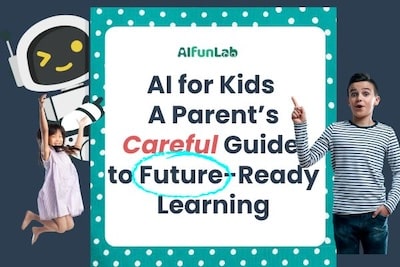In a world where AI is reshaping how we live, work, and learn, many parents wonder: Can I really teach my child about machine learning if I’m not a tech expert? The answer, backed by educators at places like MIT Media Lab and supported by countless parent success stories, is a resounding yes.
Even if you don’t know how to code or have never worked in tech, you can still give your child a head start in understanding the future. Today’s tools make it easier than ever to explore machine learning for kids in fun, hands-on, and totally non-intimidating ways.
In this guide, we’ll break down how to explain machine learning in kid-friendly terms, recommend some of the best tools and platforms, and give you unplugged activities that reinforce the same concepts—no screen required.
1. What Is Machine Learning for Kids?
Machine learning is a type of artificial intelligence that teaches computers to learn from data. But for kids?
Try this instead:
"Machine learning is when computers learn from experience, just like you learn from practice."
Example:
- You show a computer 100 pictures of cats and dogs.
- It starts to notice patterns (cats have pointy ears, dogs usually don’t).
- After a while, it can guess which new picture is a cat or a dog—even without being told.
That’s machine learning! It’s not magic. It’s patterns, logic, and decision-making—skills your kids already use every day.
2. Why Teach Machine Learning to Kids?
Understanding AI early on helps kids:
- Build critical thinking skills
- Develop digital literacy
- Get comfortable with problem-solving and data
- Prepare for the future job market
Even more importantly, kids who explore AI learn to question how technology works rather than just using it passively. That mindset makes them creators, not just consumers.
Blakeley Payne, an MIT Media Lab researcher who developed an AI + Ethics curriculum for middle schoolers, puts it this way:
"The earlier kids can start thinking about the way AI systems make decisions, the better prepared they’ll be to shape and understand the systems around them." – MIT Media Lab

3. Parents: You Don't Need Coding Experience
One of the most common misconceptions is that AI = coding.
While coding is part of AI development, tools like visual games, interactive stories, and drag-and-drop platforms allow kids (and parents!) to learn foundational concepts without writing a single line of code.
In fact, many of the most effective tools were designed for classrooms and homes where teachers and parents don’t have technical backgrounds.
4. Best Tools That Teach Machine Learning for Kids
Here are four apps and platforms that make AI accessible, fun, and educational.
a. Machine Learning for Kids (by IBM)
- Best For: Ages 8–14, classrooms or parent-guided exploration
- Key Feature: Uses Scratch (a block-based coding platform) to create real ML projects like chatbots or image classifiers.
- Why It Works: Kids get to train actual machine learning models using easy examples.
- Tech Level: Beginner-friendly
- Price: Free
"My 10-year-old built a chatbot that identifies animals. It blew his mind that he trained the computer!" – Reddit parent
b. Teachable Machine (by Google)
- Best For: Ages 7+ and curious beginners
- Key Feature: Train your own AI to recognize images, sounds, or poses in seconds.
- Why It Works: No coding, no signup, instant feedback. Kids love seeing their computer learn from them in real time.
- Tech Level: Super beginner-friendly
- Price: Free
"This was our first hands-on intro to AI. My son had it recognizing our dog in under 5 minutes!"
c. Code.org AI & Machine Learning Unit
- Best For: Ages 10–13, classroom or independent learners
- Key Feature: A guided, story-based module that introduces AI ethics, algorithms, and fairness.
- Why It Works: Builds awareness and moral reasoning alongside tech skills.
- Tech Level: Beginner (no coding required)
- Price: Free
Used in over 40,000 classrooms in the U.S. and internationally.
d. AI + Ethics Curriculum (MIT Media Lab & iThrive)
- Best For: Parents or educators guiding discussions with tweens/teens
- Key Feature: Discussion-based lessons and real-life ethical scenarios
- Why It Works: Helps kids think critically about how AI is used in everyday life
- Tech Level: No coding
- Price: Free PDF guide
5. Offline Critical Thinking Games that Teach AI Concepts
You don’t even need a screen to introduce machine learning for kids. Try these unplugged activities:
a. The Pattern Sorting Game
- Give your child a pile of mixed objects (buttons, toy animals, etc.).
- Ask them to sort based on color, then size, then shape.
- Then ask: "Can you teach ME how to do it? What rules did you use?"
This teaches classification, a core machine learning function.
b. If-Then Simon Says
- You say, "If I clap once, you spin. If I clap twice, you jump."
- Mix it up. Let your child invent the rules.
This builds understanding of "if-then" logic—the same logic used in AI algorithms.
c. Yes/No Data Detective
- You think of an object. Your child asks yes/no questions to figure it out.
- They’re essentially "training" themselves to classify by process of elimination.
Great for developing decision-tree thinking, a building block of AI.
6. What About Free AI Homework Helper Tools?
Machine learning isn’t just about creating—it’s also about support. Tools like:
- Socratic by Google (helps break down math and science homework)
- Khanmigo by Khan Academy (AI-powered tutor in development)
...are examples of ai homework helper free tools that use machine learning to adapt to students’ needs.
Just remember: the goal is understanding, not shortcuts. Choose tools that explain, not just answer.

7. Everyday Conversations That Reinforce Machine Learning Concepts
You don’t need a curriculum to keep machine learning ideas alive. Everyday moments offer opportunities to spark AI curiosity.
Here are examples of how you can naturally bring up machine learning for kids in daily life:
- At the dinner table:
“Remember how Netflix shows new cartoons you like? That’s AI learning your favorites.” - In the car:
“Google Maps just rerouted us around traffic. It learns from all the other drivers in real time.” - At the store:
“Ever notice how the cashier's screen guesses what fruit you bought? That’s a form of pattern recognition!”
These small discussions teach kids to observe how technology behaves—and to ask, why did it do that? This builds digital curiosity and agency.
8. How Machine Learning Builds Critical Thinking in Kids
Beyond tech know-how, the real superpower kids gain from learning about AI is how to think.
Understanding machine learning helps kids:
- Break down big problems into small steps
- Spot patterns in data, behavior, and logic
- Question bias and fairness in decision-making
- Learn from feedback—just like algorithms do
According to a 2024 report from the Brookings Institution, students exposed to AI literacy early were 23% more likely to question automated decisions (like how grades are scored or how search results appear). That’s digital resilience—and it starts young.
9. Which Kids Thrive Most with Early AI Exposure?
You might wonder: Is this really for every child?
Yes. But it’s especially beneficial for:
- Kids who like puzzles – because pattern recognition is their playground.
- Kids with learning differences – many adaptive AI tools support their unique pace.
- Kids who fear mistakes – AI models fail, learn, and try again. It models healthy iteration.
- Kids who love fairness – exploring AI bias teaches them to think critically about justice and systems.
In short, machine learning for kids isn’t just about building tech skills. It nurtures a mindset of inquiry, adaptability, and reflection.

10. How to Choose the Right Tool for Your Child
Every family is different. Here’s how to choose your path:
Child TraitSuggested Tool or ActivityEnjoys games & puzzlesTeachable Machine, Pattern Sorting GamePrefers structureMachine Learning for Kids (IBM), Code.org ML moduleLearns through conversationAI + Ethics curriculum, dinner table AI discussionsNeeds visual feedbackTeachable Machine, Yes/No DetectiveDoesn’t like screensOffline games (If-Then Simon Says, Classification games)
🧠 Parent Tip: Try one activity per week. Let your child lead the curiosity—then follow their questions to the next level.
You Don’t Need to Be an Expert—You Just Need to Be Curious
If you’ve ever worried, “I’m not technical enough to teach my child about AI,”—here’s your permission slip: you don’t need to be.
What your child really needs is someone who:
- Encourages their questions
- Helps them spot how tech affects their world
- Shows them learning is a lifelong adventure
As MIT’s Randi Williams, who developed AI learning kits for young kids, puts it:
“It’s not about coding. It’s about helping kids understand that computers don’t think—they follow patterns we give them. That understanding makes them powerful.”
So go ahead—train a chatbot. Sort buttons. Ask questions about fairness in your YouTube feed. You’re not just teaching machine learning for kids—you’re preparing your child to shape the future with confidence.
As a Child Development Specialist, I focus on the science of early brain growth. That lens now shapes my work exploring how AI — when used with thoughtful parental guidance — can support, or sometimes disrupt, healthy development. By staying close to both the research and the technology, I help parents make informed, intentional choices for their children.



.svg)




















